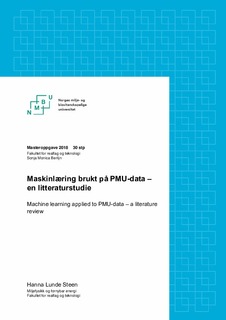| dc.contributor.advisor | Berlijn, Sonja Monica | |
| dc.contributor.author | Steen, Hanna Lunde | |
| dc.date.accessioned | 2018-07-18T09:32:37Z | |
| dc.date.available | 2018-07-18T09:32:37Z | |
| dc.date.issued | 2018 | |
| dc.identifier.uri | http://hdl.handle.net/11250/2505984 | |
| dc.description.abstract | En rekke utfordringer i kraftsystemet vil bli mer gjeldende fremover; økende kompleksitet, økende forbruk, strengere krav om forsyningssikkerhet, og hensyn til miljø og bærekraft. Dette gjør at nettet trenger å bli smartere og gi bedre kommunikasjon, overvåkning og automatisk reaksjon på hendelser. For å oppnå dette trengs mye data om nettets tilstand, hvor sensoren PMU (phasor measurement unit) er en enhet som kan bidra til dette. Den gir høyfrekvente data som er tidsstemplet og synkroniserte, som legger til rette for å kunne fange opp endringer i kraftsystemet med høy presisjon. En annen teknologi som vil kunne bidra til et smartere nett er maskinlæring. Ved hjelp av store mengder data, kan maskinlæringsmetoder bygge gode modeller som kan gjøre raske og presise prediksjoner. PMU’ens høye samlingsrate gjør at det hentes inn store mengder data som kan brukes som input til maskinlæringsalgoritmer til å sammen utvikle nettet i en smartere retning.
I denne oppgaven har fagområdet “maskinlæring brukt på PMU-data“ blitt undersøkt ved hjelp av en litteraturstudie. Det ble først undersøkt hva som er de vanligste maskinlæringsalgoritmene, før disse ble brukt som søkeord sammen med “PMU“. Disse søkene ga i alt 110 artikler, som dannet grunnlaget for videre analyse. Fagområdets sammensetning ble undersøkt ved å plotte ulike maskinlæringsalgoritmer mot ulike utfordringer i nettet som ble sett på. En rekke histogram over ulike egenskaper ved artiklene ble også presentert, blant annet geografisk opphav og type utgivelsesinstitusjon. Det ble, bassert på dette, valgt ut 5 fordypningsartikler som ble gått gjennom i detalj for å gi et dypere innblikk i de mest sentrale underområdene av fagområdet. | nb_NO |
| dc.description.abstract | Several challenges in the power system will be more substantial in the future; increasing complexity, increasing consumption, demand of increased security of supply, sustainability and environmental considerations. This causes a need for the power system to become smarter, through better communication, monitoring and automatic response to events. To achieve this, a lot of data is required that descibes the state of the network, and the sensor PMU (Phasor measurement unit) can contribute to this. It provides high-frequency data that is time-stamped and synchronized, which facilitates accurate detection of changes in the power system. Another technology that could contribute to a smarter power system is machine learning. It can, using large amounts of data, build models that can make fast and precise predictions. The high collection rate of the PMU leads to large amounts of data to be collected, that can be used as input to machine learning algorithms.
Based on a literature study, the subject area “machine learning used on PMU data“ has been studied in this thesis. After the most common machine learning algorithms were mapped, they were used as keywords together with “PMU“. These searches gave a total of 110 articles, which formed the basis for further analysis. The subject area’s composition was analysed by plotting different machine learning algorithms against various challenges in the power system that were attempted to be solved. Several histograms of various variables of the articles were presented, for example geographical origin. In addition, 5 central articles were selected to provide a deeper insight into the most central sub-areas of the subject area. | nb_NO |
| dc.language.iso | nob | nb_NO |
| dc.publisher | Norwegian University of Life Sciences, Ås | nb_NO |
| dc.rights | Attribution-NonCommercial-NoDerivatives 4.0 Internasjonal | * |
| dc.rights.uri | http://creativecommons.org/licenses/by-nc-nd/4.0/deed.no | * |
| dc.subject | PMU | nb_NO |
| dc.subject | Maskinlære | nb_NO |
| dc.title | Maskinlæring brukt på PMU-data : en litteraturstudie | nb_NO |
| dc.title.alternative | Machine learning applied to PMU-data : a literature review | nb_NO |
| dc.type | Master thesis | nb_NO |
| dc.source.pagenumber | 70 | nb_NO |
| dc.description.localcode | M-MF | nb_NO |

